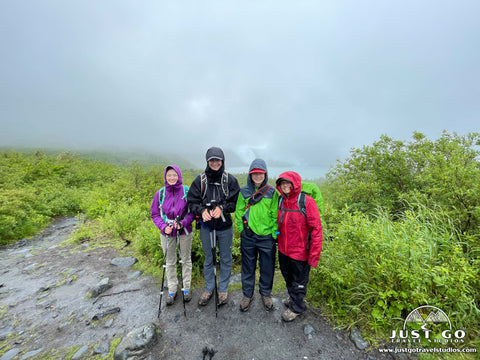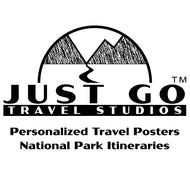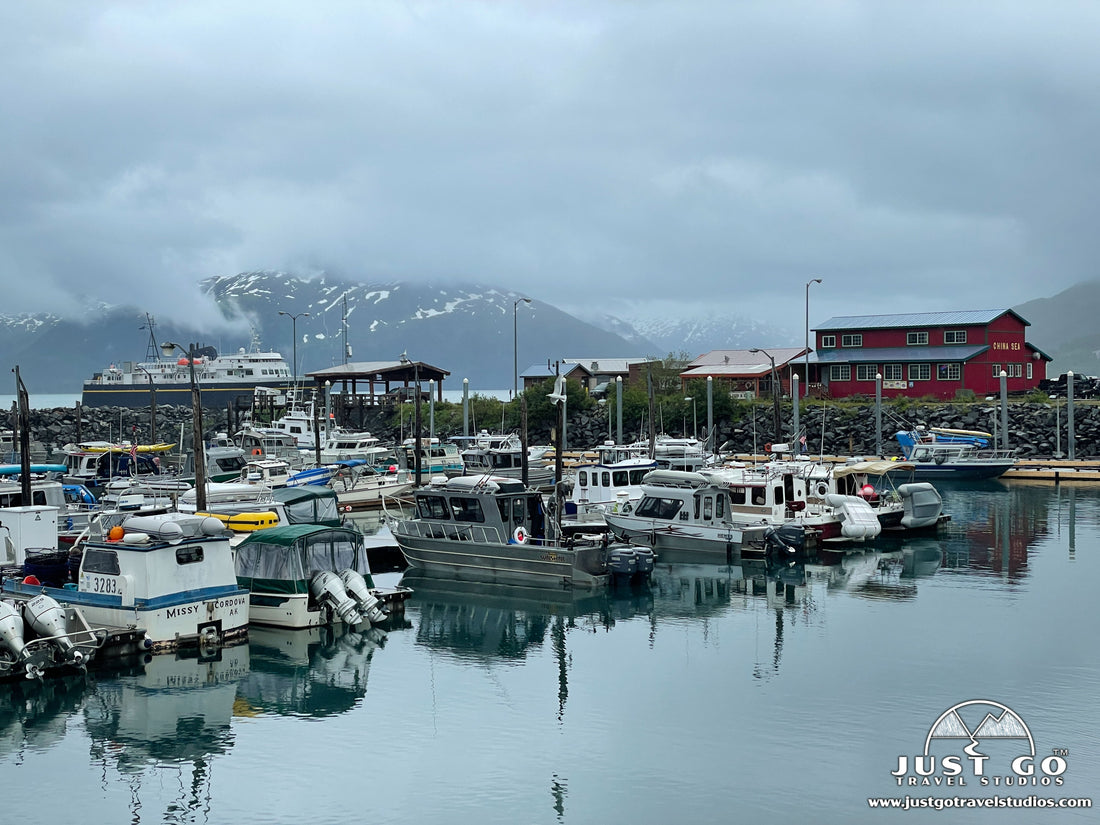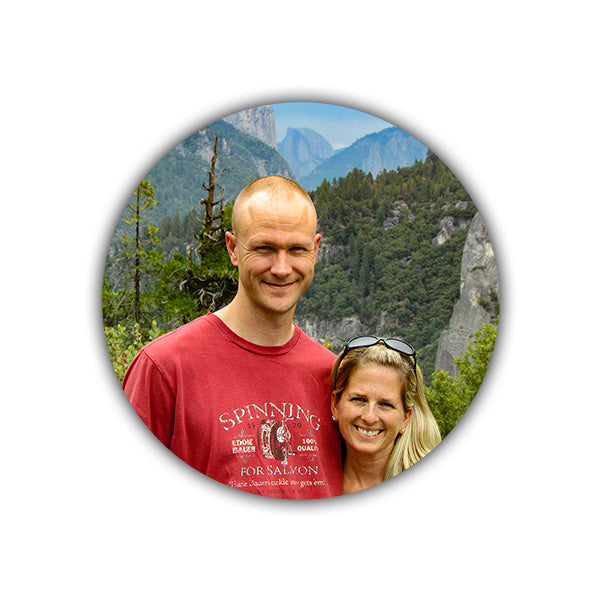Simply said, Whittier, Alaska is unlike any other town to which we’ve been. It’s one of those places that leaves you speechless at the beauty of its surroundings but also scratching your head at its strangeness.
Unless arriving via cruise or ferry on the Alaska Marine Highway, a trip to Whittier begins with an adventure in itself—a drive through a one-way, 2.5-mile tunnel, where the roadbed is railroad tracks! Once through the tunnel, Whittier comes into view, tucked between picturesque glaciers and mountains that line Passage Canal. However, it isn’t what you’d expect of a typical, waterfront town. Whittier feels more like an industrial cityscape—with a railyard, dilapidated military buildings and WWII-era Begich Towers, where most of the town’s 200 or so residents live.
As strange as all this may sound, Whittier’s accessible (90-minute drive from Anchorage) yet isolated location makes it a gateway to an almost unspoiled wilderness. Whether you choose to explore the area by water or would rather hit a trail, there are a variety of outdoorsy adventures from which to choose. Just be sure to come prepared with your rain gear...Whittier isn’t known for its amazing weather, after all.
We know from experience that you can have a great time in Whittier despite the weather! We hope our guide will give you an idea of what to expect when visiting Whittier, what to do and what plans you may want to make ahead of your trip.
WHITTIER HISTORY
For centuries, the area now occupied by Whittier served as passageway between the Prince William Sound and Turnagain Arm. It was first used by native Chugach people as part of a portage route, and later by traders, explorers, and prospecting miners. In 1915, the nearby Whittier Glacier was named for the American poet John Greenleaf Whittier. The town eventually took the same name.
It was developed during World War II when the U.S. Army constructed Camp Sullivan, a military facility with a deep-water port near Whittier Glacier. In 1941, construction of a massive railway tunnel was undertaken to connect Whittier to the rest of the rail corridor and safeguard the flow of military supplies for the defense of Alaska. Anton Anderson served as the chief engineer on the project. Once the spur of the Alaska Railroad was completed in 1943, the port became the primary entry point for U.S. soldiers into Alaska.

After the defeat of Japan, Camp Sullivan was abandoned; but the military returned a year later when Cold War events triggered the reactivation of the port. Whittier became a permanent base, which necessitated the speedy construction of the buildings that now dominate Whittier’s skyline. The Buckner Building (now abandoned and unstable) was completed in 1953 and was called the “city under one roof.” The 14-story Hodge Building (now Begich Towers) was completed in 1957 and housed dependent families and Civil Service employees. A tunnel at the base of the west tower connected the building to the Whittier School, so students could get to school safely even when the weather was bad. The base was deactivated in 1960.

Begich Tower, image courtesy of Enrico Blasutto
On March 28, 1964, an earthquake, measuring 9.2 on the Richter scale, shook Alaska and triggered a tsunami that caused millions of dollars of damage in Whittier and killed 13 people. Although much of the town was destroyed, the larger Cold War buildings were intact. In 1972, the city of Whittier purchased the Hodge Building, turned it into condominiums and renamed it Begich Towers. With most of Whittier’s present-day residents living in this building plus many of its services (post office, general store, hospital, etc.) either inside or connected to the building, it has been described as the “city under one roof.”
THINGS TO DO IN WHITTIER, ALASKA
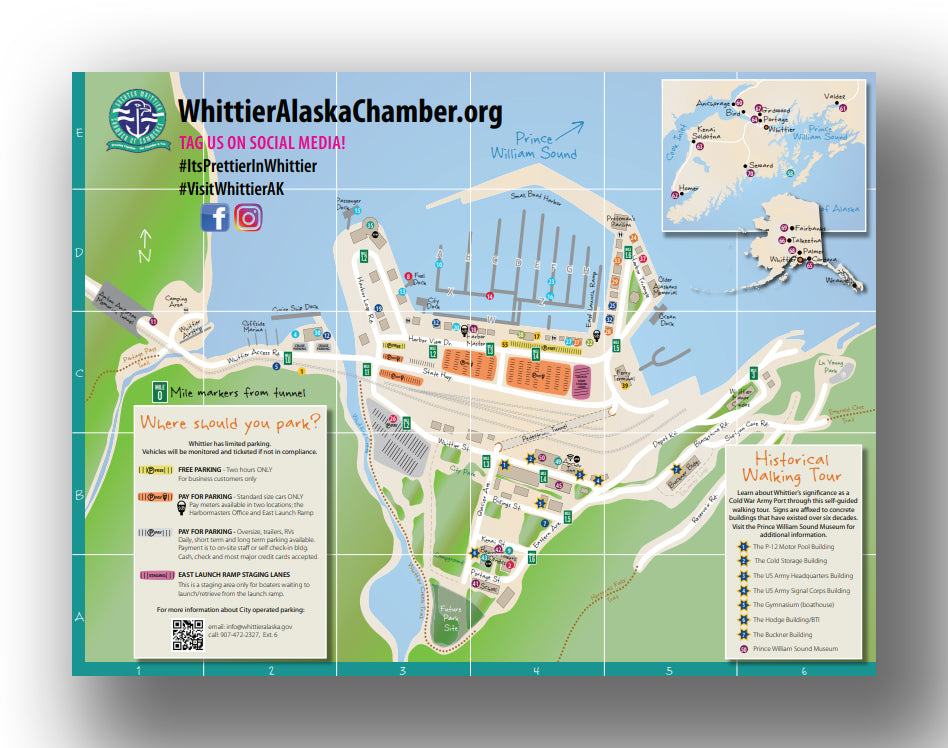
Map of Whittier, Alaska, courtesy of Whittier Alaska Chamber of Commerce
Whittier has more to offer than first appears. This unique and historic town is fortunate to be set against a stunning backdrop of glaciers and mountains that tower over the harbor. It is a great jumping off point for outdoor enthusiasts looking to explore Prince William Sound or the trails of the surrounding Chugach National Forest. Whether you just have a few hours to wander through town or plan to spend a few days taking advantage of the variety of outdoor activities, Whittier has something for everyone!
We’ve rounded up this list of some of the best things to do in Whittier, Alaska:
Drive through the Anton Anderson Memorial Tunnel
This one should be easy to check off your list since the only way to drive to Whittier is via this 2.5-mile tunnel through Maynard Mountain. [For many years, Whittier was only accessible by train, boat, or plane. However, the Anton Anderson Memorial Tunnel was overhauled in 2000 to also allow for automobile traffic.] Enjoy the unique experience of travelling through the longest combined vehicle-railroad tunnel in North America! Highway traffic and trains alternate use of the one-way tunnel, so be sure to check the Whittier, Alaska tunnel schedule in order to time your trip.

Take a stroll along Whittier’s picturesque harbor
Most businesses in Whittier are clustered along the small-boat harbor, where a combination of commercial fishing boats and pleasure vessels bob in the turquoise water. Shop for souvenirs and then walk the boardwalk behind the businesses to get a closer view of the activities in the harbor.

Wander through Whitter on a self-guided walking tour
Learn about Whittier’s fascinating history as a Cold War Army port. The Whittier Army Port Historic District Walking Tour includes seven stops and takes about 30 minutes. Accessing the start of the walking tour: From the waterfront area, follow the pedestrian tunnel under the railway. The tour starts at the corner of Whittier Street and Glacier Avenue. You’ll receive a copy of the map with the walking tour details when you drive through the Anton Anderson Memorial Tunnel (or see the map included at the beginning of this section).
Visit the Prince William Sound Museum
After your walking tour, learn more about Whittier’s interesting past at this small museum, located at the Anchor Inn. It contains exhibits about Whittier’s history and stories about the people that shaped the past—the pilots, surveyors, and engineers. The Prince William Sound Museum is open daily in the summer and there is a small admission fee to enter.
Hiking
We think one of the best ways to explore the beautiful landscape surrounding the town is to hit one of Whittier’s hiking trails. Enjoy a hike through temperate rainforests for views of waterfalls and massive glaciers! We cover hiking in detail in a later section.
Explore the waters of Prince William Sound on a sea kayaking tour
Whittier is a prime location for sea kayakers since there are numerous inlets sheltered coves and beaches to explore, plus opportunities to see marine wildlife. There are multiple outfitters that offer guided sea kayaking tours in Whittier, Alaska—ranging from several hours to multi-day trips. Kayak and gear rentals are also available from some outfitters but only for experienced paddlers.
Take a glacier cruise
The world’s largest concentration of tidewater glaciers is in the Prince William Sound. The best way to see them, plus spectacular coastal scenery and a variety of marine wildlife, is to take a glacier cruise. The waters of the sound are protected and calm, unlike some of the other open water cruises in other parts of Alaska. Cruises on larger vessels out of Whittier are a great option for those typically prone to sea sickness. Cruise companies offer both half-day cruises (4-5 hours) and full-day cruises (8-9 hours) that travel deeper into Prince William Sound to explore places like Harriman Fjord, College Fjord and Surprise Glacier.
Go fishing
Fishing is a popular summer activity since Whittier offers the closest saltwater fishing port from Anchorage. To experience world-class fishing in the rich waters of Prince William Sound, book a fishing charter. Whittier has some of the best King Salmon fishing in South Central Alaska, but lingcod, rockfish and halibut are also common. Fishing from shore is allowed in designated areas in the Whittier small boat harbor; however, it is prohibited on harbor floats, boat ramps and from the breakwater. Be sure to check Alaska’s fishing rules and regulations.
More adventurous options in Whittier
Experience Whittier at your own pace with a custom tour. Use a local water taxi for transport to a kayak drop-off point or a remote cabin or book a private charter. Seeking something more extreme? Whittier is one of the few places in Alaska where you can jet ski. Guided jet ski tours are pricey but provide a unique experience in the waters of Prince William Sound (all the gear to keep you warm and dry in included, of course!).
Visit the Portage Valley area/Begich, Boggs Visitor Center
After spending time in Whittier, we highly recommend a slight detour off Portage Glacier Road. Shortly after passing back through the Anton Anderson Memorial Tunnel, make a quick stop at the Portage Lake Overlook. Then drive a bit further west until the turnoff for the Begich, Boggs Visitor Center and Byron Glacier. The visitor center once provided great views of Portage Glacier, but the glacier retreated so fast it is no longer visible from the center. It’s still worth a stop to take in views of Portage Lake and learn about Chugach National Forest and the ecosystems of Portage Valley and Prince William Sound. To see Portage Glacier in the summer, book a Portage Glacier Cruise Tour (or hike the Portage Pass Trail on the Whittier side of the tunnel). Our favorite thing to do in Portage Valley was the Byron Glacier Trail. The 1.5-mile out-and-back hike is a great family-friendly hike that offers amazing up-close views of Byron Glacier!
HIKING TRAILS IN WHITTIER ALASKA
Portage Pass Trail
- Difficulty: Moderate / Strenuous
- Distance (round-trip): 4.2 miles
- Elevation gain: 1520 feet
- Hiking time (approximate): 2.5 to 3 hours
- Trail type: Out-and-back
- Potential hazards: Bugs, wet conditions, bears
- Restrooms: Pit toilets located at the trailhead. No restroom facilities are available on the trail.
- Recommended footwear: Hiking boots or hiking shoes
- Pets: Allowed
Trail Description
The Portage Pass Trail is by far the most popular hike in the Whittier area for good reason. This moderate, 4.2-mile out-and-back hike offers up amazing views of Passage Canal, Divide Lake and Portage Glacier. The trail begins with a steep, rocky climb (750 feet in elevation gain) to Portage Pass. Beyond the pass, the trail descends through glacial brush and past Divide Lake down to the gravel shores of Portage Lake. Hikers will need to retrace their steps back to the trailhead, which means climbing back up to the pass and descending to back to sea level on the other side.
When we hiked, due to rainy weather and increasing winds, we only made it as far as the overlook beyond Divide Lake. Despite cutting our hike short and limited views of the glacier, our kids still claim it was one of their favorite hikes in Alaska! For a shorter hiker option, climb a mile to Portage Pass for views of Passage Canal and distant views of Portage Glacier (on clear days only, since we couldn’t see the glacier from this point on our rainy hike).
Portage Pass Trail Highlights
- Amazing Scenery: The views of Portage Glacier are stunning, but you also get a chance to see mountains all around you with a ton of waterfalls. The falls are all in the distance, but they are amazing to see!
- Great Trail: Though not easy, the trail is really well maintained which is not necessarily common on all trails in Alaska.
Portage Pass Trail Challenges
- Hard: The initial climb up is steep, and it can be a bit slippery as well if it’s wet. Just take it slow on both the way up and down and you’ll be fine.
- Poor Weather: Fog, rain and cold are all normal in Whittier. Expect to have the potential to have your views blocked and be wet. Still, you’ll enjoy it!
Trailhead Directions
Access to Portage Pass Trailhead: Drive through Whittier Tunnel and take the first right (just past the bathrooms) onto a gravel road. Cross the railroad tracks and turn right onto the road that leads to the trailhead parking. NOTE: This road can be extremely rough and impassible for low clearance vehicles due to the potholes.




Whittier Creek Trail
- Difficulty: Easy
- Distance (round-trip): 0.75 miles
- Elevation gain: Minimal
- Hiking time (approximate): 30 minutes
- Trail type: Out-and-back
- Potential hazards: Bugs, wet conditions, bears
- Restrooms: Flush toilets are located in Whittier.
- Recommended footwear: Closed-toed shoes
- Pets: Allowed
Trail Description
Cross the railroad tracks and follow Whittier Creek up to the Whittier Creek waterfall at the trail’s end.
Trailhead Directions
The trailhead starts from the middle of town.
Horsetail Falls Trail
- Difficulty: Moderate
- Distance (round-trip): 2.0 miles
- Elevation gain: 700 feet
- Hiking time (approximate): 30 minutes
- Trail type: Out-and-back
- Potential hazards: Bugs, wet conditions, bears
- Restrooms: Flush toilets are located in Whittier.
- Recommended footwear: Hiking shoes or hiking boots
- Pets: Allowed
Trail Description
This trail is shorter than the hike to Portage Pass and has less elevation gain. Follow the wood-planked trail through spruce and alder forest up to a platform with scenic views of Whittier and Passage Canal. Although this spot doesn’t provide the best views of the falls, you can backtrack to the meadow and pick a spot with a view across the valley to see the face of Blackstone Ridge and Horsetail Falls.
Trailhead Directions
Access to Horsetail Falls trailhead: Trailhead parking is at the end of Reservoir Road (behind the Buckner Building).
Emerald Cove Trail / Shotgun Trail
- Difficulty: Moderate
- Distance (round-trip): 6.6 miles
- Elevation gain: 420 feet
- Hiking time (approximate): 3 to 4 hours
- Trail type: Out-and-back
- Potential hazards: Bugs, wet conditions, bears
- Restrooms: Flush toilets are located in Whittier.
- Recommended footwear: Rubber boots (for the mud)
- Pets: Allowed
Trail Description
The trail hugs the coastline and leads to waterfalls, coves, a lagoon fed by the tide and views of Prince William Sound. For shorter options, hike just a mile to stone steps that lead down to the beach or hike the trail halfway to reach Emerald Cove. This trail is notorious for being SUPER MUDDY, so trekking poles and rubber boots are recommended.
Trailhead Directions
The trailhead starts by following Shotgun Cove Road to the end and parking in the gravel lot on the left, which is also parking for Lu Yong Park picnic area.


HOW TO GET TO WHITTIER AND OTHER TRAVEL INFORMATION
Getting to Whittier certainly requires some planning, but it makes a great day trip from Anchorage.
By Car: Allow an hour and half (depending on your starting point in Anchorage) to drive from Anchorage to the Anton Anderson Memorial Tunnel. Be sure to check the schedule for traffic passing through the tunnel to time your arrival properly. It is recommended that cars be in the staging area at least 10 minutes prior to the scheduled opening. Allow another 20-30 minutes to drive through the tunnel since the opening may be delayed or you may be behind a long line of vehicles. Be mindful of the schedule for your return trip as well! For more information on vehicle classifications and toll rates for traveling through the tunnel to Whittier, Alaska, you can find more information on Alaska’s Department of transportation website.

By Rail: In the summer, the Alaska Railroad operates the Glacier Discovery Train between Anchorage and Whittier. The roundtrip rail excursion allows visitors enough time to take a day cruise out of Whittier before returning to Anchorage.
By Cruise or Ferry: Whittier is a stop on the Alaska Marine Highway ferry system. Cruises also depart from and disembark in Whittier.
PARKING IN WHITTIER, ALASKA
Whittier has limited parking. For business customers, there is limited 2-hour free parking. If you need parking for a longer period, there are parking lots where you must pay for parking. Parking for standard cars is on the harbor side of the train tracks. Pay meters are by the Harbormaster’s Office and the East Launch boat ramp. Oversized vehicles, trailers and RVs must park by Whittier Creek on the town side of the tracks. Payment is made to on-site staff. Do not park in the staging area for boaters waiting to launch.
WHERE TO STAY IN WHITTIER, ALASKA
Whittier, Alaska Lodging: There are limited options in Whittier—but the most popular is the Inn at Whittier. There are numerous lodging options in Anchorage but Girdwood (~45 minutes away) is a great option as well.
Whittier, Alaska Camping: There are two campgrounds in Whittier: Whittier Parking and Camping and the City of Whittier Campground at the Head of the Bay. The Williwaw Campground in Portage Valley (near the Begich, Boggs Visitor Center) offers more privacy with spaced out wooded sites. They include level, paved parking pads, picnic tables and fire pits. All are rustic campgrounds without any hook-ups, flush toilets, or showers.
BEST TIME TO VISIT WHITTIER, ALASKA
The best time to visit Whittier, Alaska is between June and August when temperatures are at their highest, around 60 degrees, and days are long. If you are planning to book a glacier cruise, those usually run between May and September. You should always be prepared for cool, wet weather in Whittier; and rain jackets are essential, as well a pair of waterproof hiking boots if you are planning to hit the trails.
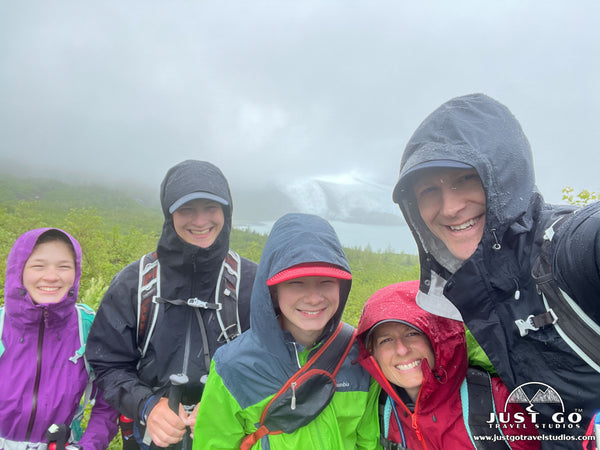
Winters in Whittier can be brutal with high winds and lots of snow. Whittier gets about 250 inches of snow annually! Days are short, and there are few open businesses in town.
Be sure to check Whittier, Alaska weather before your visit!
RELATED INFORMATION ON OTHER ALASKA DESTINATIONS FROM JUST GO TRAVEL STUDIOS
- If you are heading to Whittier, AK, then you should also check out nearby Kenai Fjords National Park. Our blog covers what to see and do in the park and how best to plan for your trip!
- If you like the history of Whittier, then you’ll love visiting nearby Independence Mine State Historical Park in Hatcher Pass.
- Check out our blog on What to See and Do in Valdez, Alaska.
- When you get back from your visit, let us make a custom, vintage-style travel poster for you! We promise you’ll love it. Just send us a photo and we’ll include your customized wording and make it a perfect travel memory!
